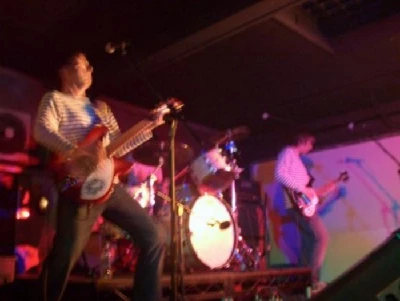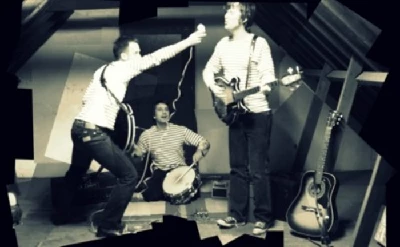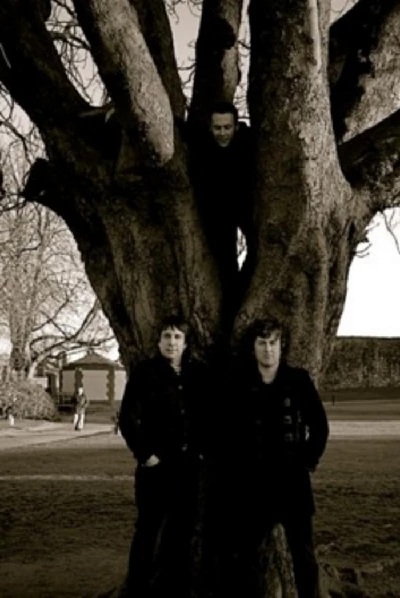published: 13 /
2 /
2010

in what is our second interview with them, Ben Howarth speaks to Gleen Page from Medway-based 60's-influenced garage rockers about their recent move to Steve Van Zandt's Wicked Cool label and their latest album, 'Pictures'
Article
I have a habit of meeting the Len Price 3 in slightly unappealing places. In 2005, when they were playing a show at Chatham’s Command House, I saw them play in a venue where a combination of a faulty pipe and a gaping leak left a pool of urine spilling on to the floor. On that occasion, we retired to lead singer Glenn Page’s nearby house and had a cup of tea in his back garden.
Camden’s Dublin Castle pub provides no such escape. The only option is a dressing room that could easily have doubled as a Victorian prison cell. Arriving 24 hours before an album launch show in their home town, they were far from inspired by the venue. Indeed, as we shake hands, they explain that we’d have plenty of time for the interview, as they didn’t think they’d bother with a sound check.
Despite this, and despite being shoehorned into the middle of a wildly inappropriate bill, alongside two metal bands with whom it is fair to say they had precisely nothing in common, they couldn’t help but give it their all upon taking to the stage. It was noticeable that each song seemed to draw an extra couple of people in from the bar, some of whom were even tempted to dance. Having ended their set with the title track of their first album, ‘Chinese Burn’ (an appropriate choice, as its chorus is a neat put-down to a Camden wannabe), they leave the stage to enthusiastic applause.
The Len Price 3’s confident, catchy garage rock is ideally suited to winning over sceptical audiences in mid-sized venues. And, despite their habit of wearing matching striped shirts, they have a healthy dislike of anything that might smack of contrivance. Page has never hid his distaste of certain aspects of the music scene - the lead song on their second album, 'Rentacrowd', berates another band, with their “Hoxton hair and their trendy sound”, saying that they wouldn’t get anywhere where he comes from. But he is no curmudgeon, and on both occasions I have interviewed him, his quick wit has most often been turned on himself.
The songs he writes tend to be fairly straightforward, but have a longer shelf life than that of most garage rock bands, due to a combination of elaborate-yet-catchy backing vocals, the occasional heartfelt ballad and a cheeky eye for detail.
I mistake one song for a dig at an aging rock star. In fact, as Glenn explains, “the song was not about that, by any means. I had a man come round to fix my boiler, who spotted my guitar, so I told him that we’d just done a session for Radio Two. He replied, ‘yeah, I’ve done that’, and explained how he’d played Sydney Opera House with the Mavericks. But then, he got very scary, right in my face, and was telling me how his wife had left him with the kids, but that he was now out going clubbing with a gang of young Russians. So, it’s a song about that weird experience.”
Since my last interview with the Len Price 3, they have changed labels. I suggested that they had given the impression in a news update on their website that their time with their first label, the Australian based Laughing Outlaw, had not been a happy one.
“I don’t know if I should put this on the record,” Glenn says in reply. “But why not? In some ways, being with Laughing Outlaw was a good experience. The guy who bankrolled the label really liked us, but the label manager was less keen, which was the right way round. We just got given money, and we got on with making a record“.
“But, then, in March 2006, we went to the US, and at one gig in New York, we played to an audience of three people: my wife and our bassist Steve’s girlfriend were two, but the other was Steve Van Zandt, who came over afterwards, bought us a drink and asked to sign us. That seemed a good idea.”
“And then there were two deciding factors when we went down to South by South West on the same tour. One, the Laughing Outlaw compilation they’d prepared as a sampler buried us three songs from the end. Two, the label manager didn’t even bother to turn up to our showcase, and when we saw him in the street, made it clear that he didn’t want to talk to us. Call me Emmanuel Adebayor, but I didn’t feel particularly loved. Laughing Outlaw did alright out of it - there was a bit of legal dispute, but they got a decent pay-off from the new label!”
Wicked Cool, Van Zandt's label, had provided the band with a much more hands on experience. “Mr Van Zandt certainly likes to put his pennoth in!”, he says with a chuckle. “He has ideas and opinions, and he likes to share them. I think we had a learning experience, realising gradually that the label manager was acting as a go-between. Steve, ultimately, wants you to make a record you are happy with.”
Later on, he returns to the subject of the influence of the label. “One thing the label are very keen on is having a say on what tracks go on the record, and in what order, so as you can imagine, that leads to some heated debates.”
“I don’t know if I should say this in an interview, really… so, obviously I will. But the opening of the album was a real bone of contention for us, or at least for me! Everyone agreed on the opening track, but after that they wanted the second song to be one that I didn’t even want on the album. The trade off was that a song they didn’t want did make it on there”.
Although the official album launch show had yet to come, ‘Pictures’ had been on the streets for a week at the time of our conversation.
“We’ve had plenty of reviews - good, bad and indifferent as usual, but the feedback we’ve had from Myspace and Facebook has been good. My wife likes it, my son likes it, our friends like it. Do you like it?”
Yes, I do, I reply. Last month, when reviewing the record, I described a band that had become increasingly ambitious and confident, while maintaining a focus on “tunes, tunes, tunes”. Glenn sees the album as a culmination of a gradual increase in confidence, with more experimentation with musical instruments and a better grasp of production. But, I agree with his assessment that there is a spirit that carries through all three of their albums.
'Pictures' took longer than its two predecessors, in total requiring a month in the studio. Most of it was recorded over three sessions, each lasting three or four days, with the band recording songs in groups as they were written. But then, a mishap involving the drum tracks required a ‘ruined’ set of tapes to be replaced.
And, having been in the can since last March, the Len Price 3 had a largely inactive second-half of 2009 while they waited until the start of the following year for the record‘s release. “There was then a lot of to-ing and fro-ing with the record label, which I didn’t pay too much mind too, and off the back of that was a lot of argy-bargy choosing artwork. A difficult birth, but only after the point when aging tapes meant we had to re-do the drum tracks”.
Page is very much the star of the show on stage, and has an oddly endearing habit of fixing members of the audience with a manic stare while in the process of slaying them with furious guitar solos (although, it is worth noting that he gets the space to do this as a result of Steve Huggins’ adept work on bass). But, from their very first single, the backing vocals from drummer Neil Fromow have been a distinguishing feature of the Len Price 3 sound. But, since that debut, they have become markedly more prominent, and much more complicated.
“The harmonies have always been there, I think - although I can barely remember recording the first record these days”, he answers. “On the second album, the song ’Australia’ ended with a huge, four-part harmony, and I think perhaps that was a bit of a turning point where we became more confident, and decided we’d make sure you could hear all the backing vocals clearly.”
“This comes from Neil”, he explains. “He loves that kind of stuff. Working on backing vocals is like a little puzzle for him. He’s just got a very good musical ear - one of these guys that can pick up any instrument and play it. He does have to be reined in - if he had it his way all our songs would sound like the Bee Gees.”
Where their previous albums could have been described as garage-rock with a hint of sixties pop, ‘Pictures’ - having kicked off with an outright blaster in the shape of the title track - tends to show off their Kinksian influences more than their Clashier side.
“I’ve always had the Kinks as an influence”, he explains. “And I think after two albums of full-on garage rock, there was a natural evolution and development. I like to think that there is always beat and energy to it, but I remember thinking during the sessions that this was heading in a really poppy direction”.
Drawing the conversation to a close, I remind Glenn of the comments he made when I last interviewed his band - where he explained that Len Price 3 was the result of a conscious decision to stop chasing the latest hip scene, and stick to the kind of music he would listen to, fully aware that it meant he wouldn’t enjoy great fame or wealth. I ask if that still holds true, five years later.
“Yeah, although the difference now is that it was almost a conscious choice not to work too hard at the band at the beginning, and now I wouldn’t have the time anyway. But I think that remains the idea. We‘re too long in the tooth to start chasing the latest scene, so we do what we do. Anything else would be ridiculous, like your mum dressing as if she was 17> It‘d be scary”
“The only reason we got a deal with the first album was because a mate passed the CD on to someone he’d worked with. Getting signed wasn’t something we worked at - the game plan was just to do a few shows, knock up a few CDs and sell them at gigs. So the fact that someone wanted to pay for it was just ‘Wahey’!”
Picture Gallery:-



